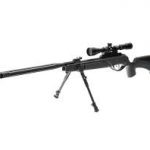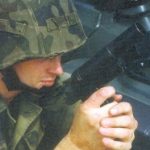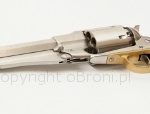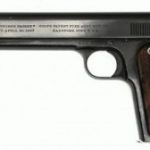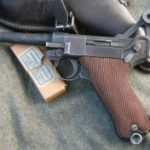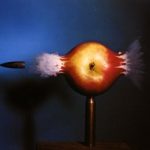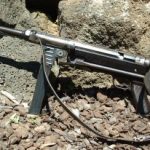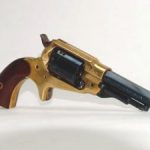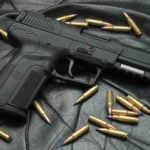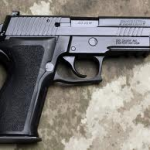Pistolet TT – tetetka.
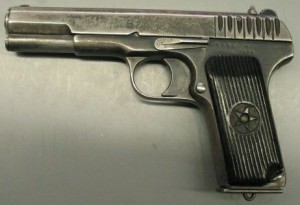
Chyba każdy z nas zna epicki już rewolwer Naganta.
Dość brzydki (aczkolwiek o gustach się nie dyskutuje), średniej wielkości, zasadniczo nic wyjątkowego. Jednakże już za pierwszym pociągnięciem za kurek oczom naszym ukazuje się całkiem wyszukany mechanizm tej broni.
Potem jeden rzut oka na kosmiczną, tym bardziej jak na tamte czasy, amunicję i już mamy pełen obraz działania jedynego rewolweru gazoszczelnego, jaki osiągnął naprawdę duży sukces i doczekał się naprawdę masowej produkcji (w tym niemałej partii w Polsce). Rewolwer był bardzo popularny, sprawował się nieźle, ale jego skomplikowany mechanizm (tak naprawdę nie zwiększający energii pocisku w wartym zachodu stopniu) oraz nie wysuwający się bęben sprawiały, że była to broń nieco skomplikowana w produkcji. Jednocześnie była czasochłonna przy ładowaniu i rozładowywaniu dla żołnierzy, nad których głowami latały pociski wystrzeliwane z broni przeciwnika – broni z wymiennymi magazynkami, chociażby z P08.
Armia Radziecka już w latach 20-tych XX wieku zaczęła pełną parą, prace nad bronią bardziej praktyczną niż wychodzący powoli z wojskowej mody rewolwer. Wynikiem tych prac był jeden z najbardziej znanych w naszym rejonie Świata pistolet samopowtarzalny – TT33 – Tulski Tokariew, czyli popularna „Tetetka”.
Broń została zaprojektowana przez zespół Fiodora Tokariewa, znanego konstruktora broni. Pierwszy prototyp gotowy był w 1930 roku (TT30), ostateczna wersja w 1933 (TT33). W szczegóły historii nie będę się tu wdawał, bo sprawdzić je można w pierwszej lepszej encyklopedii internetowej. Wolę porozmawiać o konstrukcji oraz wadach i zaletach broni w opinii mojej i kolegów – instruktorów, sportowców, kolekcjonerów. Poruszyć chcę także kwestię finansową.
Krótko o konstrukcji: bardzo dobrze widoczny za pierwszym odciągnięciem zamka, nawet dla ludzi mało obeznanych, system oparty na krótkim odrzucie lufy, ryglowanie przez przekoszenie w płaszczyźnie pionowej. Pistolet nie ma samo napinania, kurek jest zewnętrzny. I tu pierwsza wada. Broń ma dość specyficzny mechanizm kurka, który łatwo można odczepić od szkieletu, jak dla mnie, wręcz drażniąco prosto. System jest lekko osadzony, a sam w sobie, po wzięciu do ręki, przypomina konstrukcję pochodzącą z zapalniczki z kiosku. Ewidentnie działa, ale… rozłożenie go i ewentualna naprawa wymaga precyzji zegarmistrzowskiej. Wyczyszczenie w warunkach polowych jest więc właściwie niemożliwe. Może konstruktor zakładał, ze dzięki temu, że można go łatwo wyjąć, to można go w minutę zamienić na inny, ale pewnie rzadko żołnierz Armii Czerwonej nosił ze sobą zapasowy mechanizm kurka. Jaki sens miało coś takiego w starciu z Lugerem, który działać może nawet z pęknięta sprężyną spustu?
Samo rozkładanie broni jest, przyznaję, dość szybkie. Jedynym drażniącym jego etapem jest wyjęcie czegoś, co podobno F.B. (TT były oczywiście produkowane również w Polsce i wielu innych krajach) określała oficjalnie, jako „sprężynę zatrzasku zamka”, ja wolę nazwać to mocnym spinaczem biurowym. Element prymitywny do bólu, ale nie miałoby to żadnego znaczenia, gdyby nie fakt, że w dzisiejszych czasach znaczna część posiadaczy TT, tych wczesnych oczywiście, to kolekcjonerzy dbający o swoje eksponaty i utrzymanie ich wartości. Nasza „sprężyna zatrzasku zamka” w tym nie pomaga. Teoretycznie konstruktor spodziewał się chyba, że użytkownik wyjmie go przy pomocy dolnej części magazynka (denka). W praktyce jest to jak najbardziej możliwe jednakże przy małej wprawie skutkuje zarysowaniem znacznej
części szkieletu, dlatego warto położyć sobie jakiś materiał na narażonym na rysy elemencie.
Po wyjęciu naszego spinacza biurowego szybko wysuwamy zatrzask, a potem w ułamku sekundy możemy rozłożyć pistolet do czyszczenia. Przy wyjmowaniu sprężyny powrotnej polecam skupić się, bo wbrew pozorom, pociski to nie jedyne rzeczy, które mogą z pistoletu wystrzelić. Spotkanie oka z żerdzią nie należałoby do najprzyjemniejszych, ale taki jest już urok, w szczególności, pistoletów ze sprężyną umieszczoną pod lufą. Po paru sekundach mamy w ręku lufę, zamek, zatrzask, „sprężynę”, wspomniany mechanizm kurka i łożysko lufy. Dalsze rozkładanie pistoletu (np. mechanizmu kurka) jest, jak już wspomniałem, trudne oraz po prostu- nie jest zalecane.
Pistolet uchodzi za broń poręczną i stosunkowo lekką. Ale czy jest tak w rzeczywistości? Załadowany waży prawie kilogram, jednakże pamiętać należy, że jest to broń typowo na pole bitwy, nie jest to „kieszonkowy” PPK itp.
Broń dostosowana jest do amunicji 7,62x25mm (tak, tak- podobieństwo do 7,63 Mausera NIE jest przypadkowe i naboje są zamienne). W magazynku mieści się 8 sztuk plus ewentualnie jedna w komorze, ale nie jest to zalecane. O tym później.
Mamy do czynienia z pociskiem, który wylatuje z prędkością około 420m/s, osiąga energię porównywalną do pocisków wystrzelonych z Glock’a 17. Potrafi przelecieć przez wiele przeszkód, co zasadniczo nie ma sensu w pistolecie, który służył żołnierzom na polu walki i woleli oni, by oddawał całą swoją energię celowi. Zasadniczo naboje do TT i samą Tetetkę uważa się za „mocne”. Silna amunicja i prymitywna konstrukcja skutkują tu dość dużym „kopem”. Osobiście uwielbiam strzelać z TT, ale umiejscowieniu pocisku w tarczy odrzut nie służy. Jak wiadomo utrudnia złożenie się do kolejnego strzału i spada ogólna, praktyczna celność broni. Ale dyskusyjna celność TT nie wynika jedynie z odrzutu, który psuje drugi, trzeci strzał itd. Faktem jest, że nie jest to po prostu precyzyjna broń. I to samo mówili też żołnierze Armii Czerwonej. Więc doczekali się wyjątkowo „celnych” Makarovów.
Kolejną wadą jest to, że stosunkowo łatwo jest wcisnąć przycisk zatrzasku magazynka przy normalnym chwyceniu pistoletu. Dość kiepska sprawa dla żołnierza na polu walki, ale taki już urok wielu pistoletów. Skoro jesteśmy już przy magazynku, to warto dodać, że TT domyka zamek trzymający się na zatrzasku w skrajnej, tylnej pozycji
jeśli energicznie wsuniemy magazynek w rękojeść. Oczywiście przy tym zostanie też włożony nabój do komory. Wsadzając pusty magazynek – zamek się nie zwolni.
Ale w końcu nadeszliśmy do wady TT, która w moich oczach skreśla ją jako broń służącą policji i wojsku (a takie właśnie zastosowanie miała przez wiele lat również w Polsce), oraz w ogóle nadającą się do użytku przez kogokolwiek poza sportowcem, kolekcjonerem i instruktorem. Największą wadą TT33 jest fakt, iż… nie ma właściwie żadnego bezpiecznika.
Teoretycznie mówi się, że kurek można odciągnąć do połowy na „ząb zabezpieczający”, ale to jedna wielka pomyłka. Zasadniczo jedynym bezpiecznym sposobem używania Tetetki przez funkcjonariusza było chyba noszenie jej z pustą komorą i wyjętym magazynkiem.. A najlepiej, to nie nosić jej w ogóle i zamienić chociażby na P-64, kiedy były już dostępne. Część importowanych do USA Tetetek została wyposażona w zewnętrzny bezpiecznik, by spełniać pewne standardy narzucane przez tamtejsze prawo. Nie wygląda to ładnie (w Internecie znaleźć można wiele zdjęć) ale znacznie zwiększa bezpieczeństwo. Dziwne, że zakłady w Tule nie zobaczyły takiej możliwości.
Niewiele jest pistoletów z II W.Ś. , które komisy oferują w dobrym stanie po tak atrakcyjnych cenach. Widziałem raz przedwojenną Tetetkę za niecałe 400zł w stanie naprawdę nie najgorszym. Myślę, że ktoś chyba chciał ją szybko sprzedać, ale wciąż – świadczy to o tym, że ceny nie są najwyższe. W USA natomiast TT, szczególnie wojenne i przedwojenne,
ale też późniejsze: Polskie i nie tylko: osiągają ceny kosmiczne w porównaniu z naszymi. Moi znajomi – kolekcjonerzy ze Stanów Zjednoczonych, twierdzą, że można spotkać takowe nawet po 700 dolarów i nie jest to czymś zaskakującym. Może to wynikać z faktu, iż rosyjskie oryginały nie są już importowane do USA, a większość tych, które przybyły: zostały zmodyfikowane i straciły na wartości poprzez dodanie wspomnianego już wcześniej zewnętrznego bezpiecznika w okolicy zatrzasku zamka. Te nienaruszone są zatem stosunkowo drogie.
Polskie TT w Naszym Kraju możemy dostać po bardzo atrakcyjnych cenach. Słyszałem nawet o przypadkach sprzedaży przez komisy parunastu egzemplarzy w pakiecie, gdzie cena jednego wynosiła 80zł, a broń była w naprawdę niezłym stanie!
To jednakże rzadka okazja, zazwyczaj kosztują po 300-750zł.
Amerykanie chwalą sobie Tetetki. Niektórzy kolekcjonerzy porównują je do VISów i pomimo mojej dużej sympatii do TT- uważam to za dużą przesadę. Każdy z moich znajomych w USA posiadających TT twierdzi, że ich egzemplarze nigdy się jeszcze nie zacięły. Ja strzelałem w życiu z 3 różnych Tetetek, jedna wojenna i jedna polska w super stanie plus
jedna również polska w stanie raczej kiepskim. Wszystkie 3 zacinały się przy wyrzucaniu łusek. Zamek klinował ją między komorą nabojową a zamykającym się już zamkiem. Może miałem pecha po prostu.
Podsumowując- TT to legenda. Legenda w rozsądnej cenie. Idealna na początek dla osób posiadających pozwolenie w celach kolekcjonerskich. Dla innych – chyba szkoda miejsca w książeczce. Ale przecież to Państwa książeczki, więc proszę zapełniać według uznania.

